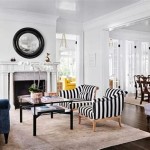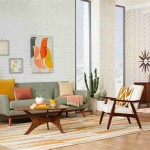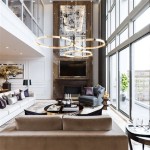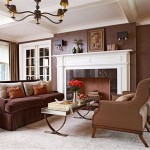Ideas for Living Room Paint Colors
The living room often serves as the heart of the home, a space for relaxation, entertainment, and connection. The right paint color can significantly impact the room's ambiance and overall aesthetic. Selecting the perfect hue requires careful consideration of factors such as natural lighting, room size, existing furniture, and desired mood.
Neutral Palettes: Neutral colors offer a timeless and versatile foundation for any living room. Shades of white, beige, gray, and taupe create a calming and sophisticated atmosphere. These hues readily complement various design styles and allow for flexibility in incorporating colorful accents through furniture and décor.
White and its Variations: Pure white can brighten a room and make it feel more spacious. However, it can also appear stark. Softer variations, such as ivory, cream, or alabaster, offer warmth and subtle dimension. Cool whites with hints of gray or blue can create a clean, contemporary feel.
Gray's Versatile Nature: Gray has become a popular choice for its versatility and ability to create a sense of calm and elegance. Light grays provide a backdrop for vibrant artwork and furnishings, while darker shades can add drama and depth to a larger living room. A mix of warm and cool grays can create a balanced and inviting space.
Beige and Taupe for Warmth: Beige and taupe offer warm, earthy tones that create a cozy and inviting environment. These hues pair well with natural materials like wood and stone. They can be layered with other neutrals or accented with bolder colors for a dynamic look.
Embracing Bold Colors: For those seeking a more vibrant and expressive living room, bold colors offer a powerful design statement. Deep blues, rich greens, warm terracotta, or dramatic reds can inject personality and energy into the space. Careful consideration should be given to the room's size and lighting when selecting a bold hue.
Blue's Calming Influence: Blue has a calming and tranquil effect, making it a popular choice for living rooms. Lighter blues create an airy and refreshing feel, while deeper blues evoke a sense of sophistication and drama. Navy blue can be particularly striking when paired with crisp white trim and metallic accents.
Green's Connection to Nature: Green brings a touch of the outdoors inside, creating a sense of peace and tranquility. Soft sage greens evoke a calming atmosphere, while deeper emerald greens add a touch of luxury and richness. Olive green can create a warm and inviting space, particularly when paired with natural wood elements.
Red's Energetic Vibe: Red is a bold and energetic color that can create a dramatic focal point in the living room. Deep burgundy or maroon shades offer a sense of richness and sophistication, while brighter reds can be stimulating and energizing. Consider using red as an accent wall or incorporating it through furniture and accessories.
Yellow's Cheerful Disposition: Yellow is a cheerful and optimistic color that can brighten any living room. Pale yellows create a light and airy feel, while deeper gold tones add a touch of warmth and elegance. Yellow can be particularly effective in rooms with limited natural light.
Considering the Impact of Lighting: Natural light plays a crucial role in how paint colors appear in a room. North-facing rooms tend to receive cooler light, while south-facing rooms receive warmer light. Testing paint samples on the walls at different times of day is essential to see how the colors change in varying light conditions.
Room Size and Dimensions: The size and dimensions of the living room also influence color choices. Light colors can make a small room feel larger and more open, while darker colors can create a cozy and intimate atmosphere in a larger space. Ceiling height should also be considered. Lighter colors can make a low ceiling appear higher.
Existing Furniture and Décor: The existing furniture and décor should be considered when selecting a paint color. The wall color should complement the existing pieces and create a cohesive look. If the furniture is neutral, bolder wall colors can be introduced. If the furniture is brightly colored, a more neutral wall color might be preferable.
Creating a Desired Mood: The desired mood for the living room is a crucial factor in choosing a paint color. Cool colors like blue and green create a calming and relaxing atmosphere, while warm colors like red and yellow can be more energizing and stimulating. Neutral colors offer a versatile backdrop for creating any desired mood.
Accenting with Trim and Molding: Trim and molding offer an opportunity to add depth and visual interest to the living room. Using a contrasting color for the trim can highlight architectural details and create a polished look. White trim is a classic choice that complements a wide range of wall colors.
Testing Paint Samples: Before committing to a paint color, testing samples on the walls is crucial. Paint a large enough area to get a true sense of the color in the room's lighting. Observe the samples at different times of day to see how they change in varying light conditions. This will help ensure the final selection creates the desired effect.

Living Room Paint Color Ideas And Tips To Match The Right

30 Living Room Paint Colors Inspiration For An Inviting Space Beamin Moore Wall Color Schemes

20 Living Room Paint Colors We Love Hgtv

5 Neutral Living Room Paint Color Ideas Design Cafe
The Best Paint Colors For Living Rooms In 2024

Living Room Paint Colors The Home

Dulux Living Room Paint Colours
.jpg?strip=all)
Two New Living Room Paint Colors Dream Green Diy
.jpg?strip=all)
Two New Living Room Paint Colors Dream Green Diy

8 Vibrant Living Room Paint Color Ideas Dumpsters Com








